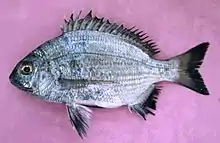Crenidens crenidens
Crenidens crenidens, the karanteen seabream or karanteen, is a species of ray-finned fish from the sea bream family Sparidae which was described by the Swedish zoologist Peter Forsskål in 1775. It is native to the western Indian Ocean but has colonised the eastern Mediterranean Sea since 1970. It is one of only two species in genus Crenidens, the other being the little known Crenidens macracanthus.
| Crenidens crenidens | |
|---|---|
 | |
 | |
| Scientific classification | |
| Kingdom: | Animalia |
| Phylum: | Chordata |
| Class: | Actinopterygii |
| Order: | Perciformes |
| Family: | Sparidae |
| Genus: | Crenidens |
| Species: | C. crenidens |
| Binomial name | |
| Crenidens crenidens (Forsskål, 1775) | |
| Synonyms[2] | |
|
Sparus crenidens Forsskål, 1775 | |
Description
Crenidens crenidens has an oblong to ovoid shaped body which is slightly compressed. Smaller adults, less than 19.7 cm in length, show a nose like bump in front of the eye. The mouth extends back to the anterior nostril and there are three rows of teeth in each jaw, the upper front jaw has 8-9 brown-tipped incisor like teeth, each bearing five denticulations which give the edge of the teeth a wavy appearance. The inner rows have a few teeth of similar form but the other teeth are granular. The scales finely ctenoid, the scaly cheeks contrasting with the scaleless interorbital region. The dorsal fin has eleven each of spiny and soft rays, while the anal fin has three spiny and ten soft rays. The caudal fin is forked. There are 52-60 scales making up the lateral line.[3][4]
C. crenidens is silvery greenish-blue or olive in colour with darker narrow longitudinal stripes created by dark spots on the scales which are above the level of pectoral fins; the fins are coloured dull yellowish or olive with a dark margin on the dorsal fin and infrequently the axil pectoral fin shows darkish axils. They can grow to 30 cm in length in their native range, although the maximum in the Mediterranean is 20 cm, the more usual measurement is between 10 and 16 cm in length.[3]
Distribution
Crenidens crenidesn is indigenous to the western Indian Ocean from the Red Sea to the Nicobar Islands south along the coast of eastern Africa to KwaZulu Natal, South Africa, rarely as far as East London, it has also been reported from southern Madagascar.[5] In 1970 it was recorded for the first time in the eastern Mediterranean in the Bardawil Lagoon in the northern Sinai Peninsula and has since spread to Israel and to Libya. The most likely route for this species to have followed to colonise the Mediterranean is through the Suez Canal as a Lessepsian migrant.[3]
Biology
Crenidens crenidens is found in shallow coastal water, over sandy substrates which are frequently covered with sea grass.[3] Its main food is algae but it also feeds on smaller invertebrates, such as crustaceans and worms.[5] The eggs and larvae are planktonic.[3] Off the Libyan coast C. crenidens has developed a distinct breeding season from November to February and the fish move away from the coast to spawn elsewhere in March and April. The males attain sexual maturity at 14 cm length and some females reach maturity at around 13 cm to 13.9 cm but for 50% of females maturity occurs at around 15.4 cm length. Fecundity is dependent on the weight of the female and varies from 678 eggs in smaller females to 9,888 eggs.[1]
Taxonomy
There are two generally recognised subspecies:
- C. c. crenidens (Forsskål, 1775) which occurs in the Red Sea and southwards along the eastern African coast;
- C. c. indicus Day 1873 which extends from the Red Sea to the Persian Gulf and Nicobar Islands.
The two subspecies occur sympatrically in the Red Sea.[3][6] Recent work has suggested that C.c. indicus be raised to species level once more and that a third species which is currently regarded as a junior synonym of C.c. indicus, Crenidens macracanthus, known from only two specimens from the Arabian Sea, is a separate valid species.[7]
Uses
Crenidens crenidens is caught all year round in the northern Indian Ocean using trammel nets and beach seines and is consumed fresh, however, in the southern part of that Ocean it is fished mainly for bait.[5]
References
- B.Q Mann; C.D. Buxton; D. Pollard; D.E. Carpenter (2014). "Crenidens crenidens". IUCN Red List of Threatened Species. 2014. Retrieved 2 February 2017.
- "Synonyms of Crenidens crenidens (Forsskål, 1775)". Fishbase.org. Retrieved 2 February 2017.
- Daniel Golani; Enric Massutí; Lidia Orsi-Relini; Jean-Pierre Quignard; Jakov Dulčić; Ernesto Azzurro (2002). "Crenidens crenidens ". CIESM Atlas of Exotic Fishes in the Mediterranean Sea. Commission Internationale pour l'Exploration Scientifique de la Mer Mediterranée. Retrieved 2 February 2017.
- J.C Hureau (ed.). "Karenteen sea bream (Crenidens crenidens)". Marine Species Identification Portal Fishes of the NE Atlantic and the Mediterranean. ETI Bionoformatics. Retrieved 2 February 2017.
- Pascualita Sa-a; Roxanne Rei Valdestamon (2016). R. Froese; D, Pauly (eds.). "Crenidens crenidens (Forsskål, 1775)". Fishbase. Fishbase.org. Retrieved 2 February 2017.
- N. Bailly (2016). "Crenidens crenidens (Forsskål, 1775)". World Register of Marine Species. Retrieved 2 February 2017.
- Yukio Iwatsuki; James Maclaine (2013). "Validity of Crenidensmacracanthus Günther 1874 (Pisces: Sparidae) from Chennai (Madras), India, with taxonomic statuses of the congeners (abstract)". Ichthyological Research. 60 (3): 241–248. doi:10.1007/s10228-013-0342-2.
